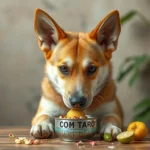
Introduction
Dog nutrition plays a crucial role in the overall health and well-being of our furry friends. Proper nutrition ensures that dogs receive the essential nutrients they need to thrive, maintain energy, and support their immune system. Each dog has unique dietary needs depending on factors like age, breed, size, and activity level.
One significant concern in the realm of dog nutrition is Dilated Cardiomyopathy (DCM), a serious heart condition that affects various breeds of dogs. Understanding DCM and its connection to diet is vital for dog owners. Recent studies have raised alarms about certain dietary practices that may contribute to the development of this condition.
This article aims to inform readers about the best dog foods to avoid DCM and provide actionable tips for ensuring a nutritious diet for dogs.
Understanding Dog Nutrition
Basic Nutritional Requirements
Dogs, like humans, require a balanced diet to maintain good health. The primary components of dog nutrition include:
-
Proteins: Essential for growth, maintenance, and repair of tissues. High-quality protein sources include chicken, beef, fish, and eggs.
-
Fats: Provide energy and support cell function. Healthy fat sources include fish oil, chicken fat, and flaxseed oil, which are rich in omega-3 and omega-6 fatty acids.
-
Carbohydrates: While dogs are primarily carnivorous, carbohydrates provide a source of energy and fiber. Ingredients like brown rice, sweet potatoes, and oats can contribute beneficially.
-
Vitamins and Minerals: Essential for various biological functions, vitamins like A, D, E, and B-complex are crucial, alongside minerals like calcium and phosphorus.
Life Stage Nutrition
Dietary needs vary significantly across different life stages:
-
Puppies: Require higher protein and fat levels to support rapid growth and development.
-
Adult Dogs: Need a balanced diet to maintain weight and health.
-
Senior Dogs: Often require lower calorie diets with joint support supplements.
Pregnant or nursing dogs also have special dietary needs to support their puppies’ development.
The Link Between Diet and DCM
What is DCM?
Dilated Cardiomyopathy is a condition that affects the heart muscle, leading to a decrease in its ability to pump blood efficiently. This can result in congestive heart failure and is particularly prevalent in certain breeds, such as Doberman Pinschers and Boxers. Symptoms include lethargy, coughing, difficulty breathing, and fainting.
Research and Findings
Recent studies have suggested a potential link between certain diets and the onset of DCM. In particular, grain-free diets and those high in certain legumes (like peas and lentils) have raised concerns. The presence of these ingredients in dog food formulations has been scrutinized, as they may lead to nutritional imbalances that contribute to heart issues.
Risk Factors
While certain breeds are genetically predisposed to DCM, dietary choices can exacerbate the risk. Factors like lifestyle, exercise, and overall health also play significant roles in a dog’s likelihood of developing this condition.
Best Dog Foods to Avoid DCM
Ingredient Lists to Monitor
When selecting dog food, it’s essential to scrutinize ingredient lists for potential red flags:
-
Grains: Contrary to some beliefs, grains are beneficial in many dog diets. Ingredients like brown rice and oats can provide necessary nutrients and fiber.
-
Legumes: High levels of peas, lentils, and chickpeas have been linked to DCM in certain cases. It’s crucial to ensure these ingredients are balanced with other protein sources.
-
Protein Sources: Look for high-quality animal proteins, such as chicken, beef, or fish, as primary ingredients, rather than plant-based proteins that may not provide complete nutrition.
Recommended Dog Food Brands
Certain brands have developed formulations aimed at reducing the risk of DCM. Here are some reputable options:
-
Hill’s Science Diet: Offers balanced nutrition with a focus on high-quality proteins and essential nutrients.
-
Royal Canin: Known for breed-specific formulas that cater to the unique needs of various breeds.
-
Purina Pro Plan: Provides a range of diets, including options with grain and lower levels of legumes.
When selecting dog food, always check for AAFCO (Association of American Feed Control Officials) approval on the label, indicating that the food meets established nutritional standards.
Homemade Dog Food Considerations
Homemade diets can offer benefits but come with risks if not formulated correctly:
-
Pros: Control over ingredients, avoiding allergens, and catering to specific dietary needs.
-
Cons: Difficulty in ensuring a complete and balanced diet, potential for deficiencies.
If considering homemade dog food, consult with a veterinarian or a pet nutritionist to ensure all essential nutrients are included. Common mistakes include neglecting calcium sources and failing to provide sufficient protein.
Signs of Poor Nutrition and DCM
Recognizing Nutritional Deficiencies
Poor nutrition can manifest in various ways, including:
- Dull coat and skin issues
- Weight loss or obesity
- Lethargy and decreased activity
Behavioral changes such as irritability or lethargy can also indicate nutritional deficiencies.
Identifying DCM Symptoms Early
DCM can develop subtly, making regular vet check-ups crucial. Signs of DCM may include:
- Coughing or difficulty breathing
- Abdominal swelling or bloating
- Fainting or weakness
Early detection can significantly improve outcomes, so it’s essential to remain vigilant and proactive in monitoring your dog’s health.
Transitioning to a Safe Dog Diet
How to Assess Current Dog Food
Evaluating your dog’s current food is the first step in ensuring their diet is safe. Look for:
-
Ingredient Quality: Ensure high-quality proteins are listed first.
-
Grain Inclusion: Avoid foods that completely exclude grains unless specifically required for allergies.
-
Legume Content: Monitor the levels of peas, lentils, and chickpeas in the ingredient list.
Steps to Transition
Transitioning to a new diet should be done gradually to avoid gastrointestinal upset:
-
Gradual Introduction: Start by mixing a small amount of new food with the old food, gradually increasing the new food’s proportion over a week to ten days.
-
Monitor for Changes: Keep an eye on your dog’s behavior, appetite, and stool consistency during the transition.
-
Stay Consistent: Once transitioned, maintain a consistent feeding routine.
Consulting with a Veterinarian
Professional guidance is invaluable when it comes to dog nutrition. A veterinarian can help you choose the right food based on your dog’s specific needs, health status, and lifestyle. Regular check-ups can also help monitor for any developing health issues related to diet.
Conclusion
Ensuring proper dog nutrition is vital for preventing DCM and promoting overall health. By being informed about the best dog foods to avoid DCM, dog owners can make educated decisions that align with their pets’ dietary needs. Selecting high-quality foods, monitoring ingredient lists, and consulting with veterinarians are essential steps in safeguarding your dog’s health and well-being.
Investing in quality dog food and staying informed about nutritional needs can make a significant difference in your pet’s life. Regular consultations with a veterinarian will also help in maintaining optimal health and preventing potential issues related to diet.









